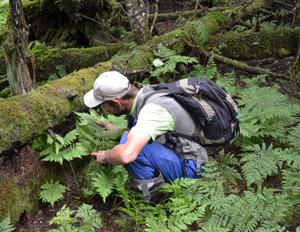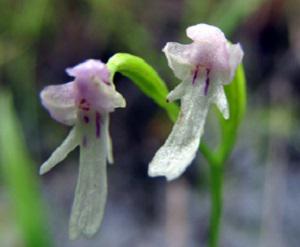Polina Volkova
To obtain lacking information about status of populations of endangered 17 plant species on the island Kunashir (Southern Kuril Islands).

Yurij Kopylov-Guskov determinating ferns. © D. Zakharchenko.
It is evident that detailed information about distribution of species and status of their populations is essential for evaluation of their vulnerability and effective biodiversity conservation. However, such information on species biology is sometimes absent even for the species known to be highly rare and endangered, thus decreasing the possibility of their adequate protection. Usually such “mysterious” species have restricted range on the poorly accessible territories where detailed studies are hampered by resource deficiency. The example can be found on the Kuril Islands, situated in remote south-eastern “corner” of Russia. These islands have unique and diverse flora due to complex geological history, connections with nearby parts of mainland etc. Flora of northern Kuril Islands was formed under influence of Beringian florogenetic centre and has much in common with flora of Kamchatka. Flora of southern Kuril Islands was influenced by Japanese florogenetic centre, being unique for the huge territory of Russia. Many of the rarest Russian plant species are known only from southern Kuril Islands that act as northern border of the distribution of such species.

Rare orchid Amitostigma kinoshitae, endemic of Japan and Kyrily islands. © Yu. Kopylov-Guskov.
According to the Red Book of Russia, the actual and explicit information about population status of 17 plant species that exist in the country only on the southern Kuril Islands is missing, search for new populations of these species is required. These species include: Hydrocotyle ramiflora, Betula maximowicziana, Chloranthus serratus, Bothrocaryum controversum, Daphniphyllum humile, Carex incisa, Carex insaniae, Rhododendron tschonoskii, Schizophragma hydrangeoides, Erythronium japonicum, Magnolia hypoleuca, Amitostigma kinoshitae, Habenaria yezoensis, Tilia maximowicziana, Athyriopsis japonica, Athyrium wardii, Arachniodes mutica. Most of the listed species are found only on the island Kunashir, characterized with the richest flora. In this project we are going to reveal exact actual status of known populations of these species on the island Kunashir and look for new, previously unknown populations in suitable habitats from remote and not yet investigated locations. The obtained information will be disseminated in various ways, allowing to perform better protection of these species, monitoring of the populations and ecological education of the local community.